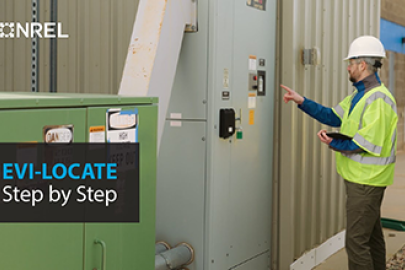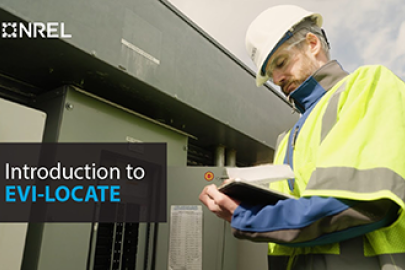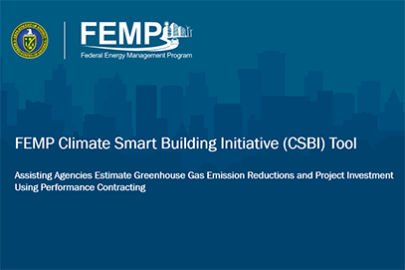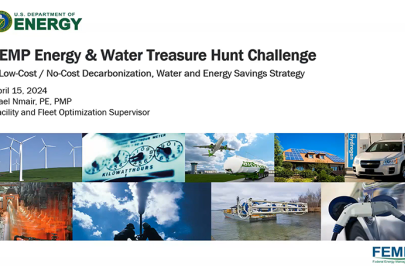Webinar provides overview about Phase 2 of the Assisting Federal Facilities with Energy Conservation Technologies (AFFECT) Bipartisan Infrastructure Law (BIL) Federal Agency Call (FAC).
Federal Energy Management Program
May 14, 2024The Federal Energy Management Program (FEMP) hosted an informational webinar about Phase 2 of the Assisting Federal Facilities with Energy Conservation Technologies (AFFECT) Bipartisan Infrastructure Law (BIL) Federal Agency Call (FAC).
Visit the Clean Energy Infrastructure Funding Opportunity eXCHANGE for access to more information about AFFECT.
SOUDEH MOTAMEDI: Hello. And welcome to the AFFECT BIL FAC Phase 2 Informational Webinar. I'm Soudeh Motamedi, the program manager for this specific grant program, as managed by the Federal Energy Management Program or as known by many, FEMP. And I will be your host today. Please, note this webinar is being recorded and will be posted on the US Department of Energy's Clean Energy Infrastructure Funding Opportunity eXCHANGE Page, also known as the S3 eXCHANGE.
During this webinar, I will be providing an overview of the Assisting Federal Facilities with Energy Conservation Technologies Program or AFFECT, along with key information for the current open Federal Agency Call or FAC and some frequently asked questions. DOE's authority for AFFECT derives from the Energy Policy Act of 1992, as codified in 42 US code section 8256(b), with the stated purpose of providing competitive grants to federal agencies to assist them in meeting the energy and water conservation requirements in Section 543 of the National Conservation Policy Act as amended.
Funding for the grant program is appropriated and varies each year. In 2022, the grant program received $250 million if you had the Bipartisan Infrastructure Law known as BIL. 42 US Code Section 8256, Federal Energy Efficiency Fund also referred to as FEEF at times, authorized the Secretary of Energy to establish a fund with the stated purpose of providing competitive grants to federal agencies to assist them in meeting the energy and water conservation requirements in section 543 of the National Energy Conservation Policy Act, as amended or also known as 42 US Code Section 8253.
Section 8256(b) also lays out the determining factors for selection, which all AFFECT FACs must adhere to. These factors consist of the cost effectiveness of the project, amount of cost savings anticipated, amount of funding committed by the applicant, extent to which financing from other non-federal sources is leveraged, and other factors as determined by the Secretary.
Per the authorizing statute, all AFFECT FACs support agencies in meeting their energy and water conservation requirements. Some of the goals and requirements of the section 8253 are metering for utility use, reducing energy use intensity, reducing water use intensity, benchmarking buildings, improving operations through evaluations, identification, and implementation of measures. Ensuring performance of implemented measures. And of course, investing and implementing in measures.
Delving a little bit more into the basics of FEEF. Cost effectiveness is demonstrated by illustrating an improvement. Total present value cost is less than the total present value cost of its savings over the useful life of the improvement. I'm a fan of the National Institute of Standards and Technologies AKA NIST, Life Cycle's Cost Effectiveness tool.
The tool does ask for a lot of information, but the information is helpful in providing a solid analysis for the project. Cost savings includes energy and water cost savings from reductions in use, operations and maintenance savings, and/or repair replacement cost savings. Note, the study period for these cost savings is 40 years when conducting a Life Cycle Cost Effectiveness Analysis.
This is a limit set in statute, but one that does not lend itself well to projects, especially when leveraging performance contracts with contract performance periods of 25 years. To address the delta in years for the two different criterias and analysis, one option is to bundle measures with different service life and cost savings, while another option is to leverage AFFECT grants.
Then we have Cost Share. Cost Share is the applicant or agencies committed funding to the project. This can include federal funds and/or financing from non-federal sources. Note leveraging of non-federal sources such as performance contracts can contribute to the Energy Act of 2022 requirement that 50% of projects under Section 8253 are implemented through performance contracts.
Finally, the other factors which allows for some customization of each FAC. This could be to support administration parties, advancement of certain technologies or other criterias. Now for the basics of each FAC. In the description section of each FAC, there's a description of the background, purpose of the program, the objectives and strategic goals, and topic areas.
For the FEMP AFFECT FAC, the strategic goals and topic areas will vary, but the background and purpose are set in statute. So those typically don't change. Then there are the parameters of the FAC. These include applications specifically not of interest, award information, which includes required deliverables for release of funding, eligibility information, and finally, application and submission information.
Then there is an award administration section. This outlines the technical review criteria, which is how each application will be scored. Let me repeat that. How each application will be scored is in the technical review criteria area. Other selection factors and the overall process for selection along with other requirements that the grant selectees are subject to are also addressed in the award administration section.
When applying to a grant, it is important to be aware of the funding release timeline relative to your project. For AFFECT, typically the application period is about three months. The evaluation selection notification is about six months or less. Just depends on the complexity of the FAC topic area, number of applications, number of reviewers, et cetera. Once selected, there's a negotiation period. This is about two to three months, during which we discuss and settle on deliverables, timelines, performance expectations.
Then there's award performance period, which you work on the deliverables as set through the negotiation period. In the case of AFFECT, the deliverables are specific to the project stage as described in the FAC. So each one will be different. Please read the FAC, as they set the different deliverables. And it will vary. Once all required final documents are submitted and access and systems are in place, funding may be released.
Timing for award performance and funding release varies by project. All AFFECT projects are subject to congressional reporting. And this is an ongoing process. Now for the current open AFFECT FAC. The AFFECT BIL FAC is currently open for phase 2 applications, which are due June 27th, 2024. The total grant amount for all phases is $250 million.
The AFFECT BIL FAC focuses on advancing net-zero federal facilities with four topic areas to support net-zero buildings at different project stages. To view the FAC, required documents, selection criterias, and apply to this FAC, please visit the Clean Energy Infrastructure eXCHANGE Email the AFFECT BIL FAC team at [email protected] if you have any questions. Please note the team is unable to respond directly to questions, but will post answers on eXCHANGE.
Based on phase 1 lessons and feedback from stakeholders, phase 2 has been slightly modified to allow an extended application period by one month. The scope of topic area 1 has been expanded to include program and procedure development assistant. The selection criteria have been refined to include benchmark example. And the application documents have been updated to reflect these modifications. If you have downloaded or started an application during phase 1, please be sure to use the most current application form and not the old ones.
Some key dates to note for this FAC are highlighted here. FEMP will be holding a lessons learned and best practices for AFFECT on June 5. Phase 2 submission, it closes on June 27, 2024, with selection announcements expected in winter 2024. The next phase and final phase of this FAC will open three months before the April 18, 2025 deadline. And selection notifications are expected for fall 2025.
FEMP intends to expend these funds over approximately the next two years. That may issue one multiple or no awards. FEMP will consider individual awards greater than the historical average, but not in excess of $10 million. Finally, FEMP does not intend to allocate more than 5% of the AFFECT BIL grants to topic area 1A and 1B, for assistance with project opportunity development or program procedure development, respectively.
Relative to phase 1, the maximum amounts per topic area 1A and 1B have increased from 100,000 to 200,000. Otherwise, the values have remained the same at a max of 10 million. Net-zero buildings, as it is used in this FAC, relies on net-zero building-related definitions provided in the implementing instructions for executive order 14057.
And as used in this FAC, net-zero building refers more generally to a building that is a net-zero emission, water, and/or waste building to allow for flexibility in meeting requirements and priorities of agencies. Now, for an overview of each topic area. Topic area 1 focuses on providing assistance with net-zero buildings opportunity development, recognizing that project starts can be complicated.
To ensure good project that is replicable or scalable, upfront investment for technical assistance is a necessary cost. As such, applications submitted under topic area 1A offer assistance requests to initiate and develop an opportunity that will lead to a replicable process or project for future net-zero buildings.
For future net-zero-- I'm sorry. --replicable award process that will lead to near future net-zero building project. For purposes of this FAC, assistance include, but may not be limited to review of identified ECMs to determine life cycle cost-effectiveness, analysis of ECMs to determine the feasibility of a performance contract and development of documentation and analysis to pursue a project.
Agencies that are awarded under topic area 1A, may submit an application and their topic area 2 or topic area 3 during the future and last AFFECT BIL FAC submission rounds. Applications for this topic area will be evaluated against the selection criteria of value and funding impact of the potential project weighed at 30%, viability of the project weighed at 35% and anticipated benefits of the project weighed at 35%.
The final deliverable is required to trigger grant release for this topic area consists of issued notice of opportunity for an ESPC or an enable project, issued letter of interest or source sort request for proposals for UESC project. Or an issued request for proposal or request for a quote for projects via their procurement mechanisms.
Topic area 1B is new and focuses on providing assistance with net-zero buildings programs and procedure development to help create a pipeline of future net-zero buildings projects. Applications submitted under topic area 1B may consist of support for portfolio analysis of viable net-zero building opportunities across facilities within a region or bairro or developing a campus master plan for net-zero buildings.
Again, agencies that are awarded under this topic area 1B may submit an application under topic area 2 or 3 during the last phase of the AFFECT BIL FAC. Applications for this topic area will be evaluated similar to the topic area 1A. Again, it will be value and funding at 30% viability and 35% and anticipated benefits at 35%.
The final deliverables required to trigger grant release for this topic area consists of an RFP or an RFQ for a third-party consultant or an in-house consultant. Topic area 2 focuses focuses on modification of existing projects to add net-zero buildings ECMs to a previously awarded contract. Please note, it is the applicant's responsibility to ensure an existing contract is eligible under this topic area by working with the appropriate contracting personnel for your agency.
Topic area 2 will be evaluated against criteria that align much more closely to the law authorizing the grant program. Each application will be evaluated based on the cost effectiveness of the project weight at 20%, anticipated energy and cost savings weighed 15%, leverage at 20%, programming priorities and policy considerations at 20%, and finally, liability risks replicability and scalability at 25%.
The final deliverables required to trigger grant release consist of issued amendment of solicitation or modification of contract known as SF-30 form or in equivalent form or a project proposal provided by the ESCO or utility to the applicant. Topic area 3's focuses is on new or in development net-zero buildings projects that have not been awarded yet.
Topic area 3 similar to topic area 2 will be evaluated against the criteria to align with the authorizing law. Just to go over it really quickly, this is cost effectiveness at 20%, anticipated energy and cost savings at 15%, leverage at 20%, programming priorities and policy considerations at 20, viability risk, replicability, and scalability at 25%.
For this topic area, the final deliverables required to trigger grant release consist of issued notice of opportunity, notice of intent to award, and project proposal provided by the ESCO to the applicant for an ESPC or ENABLE project issued a letter of interest or source request for proposal notice to proceed to investment grade audit and project proposal provided by the utility or an issued request for proposal, request for quote, and awarded contract to projects executed via other procurement mechanism.
Now, for an overview of eligibility. The BIL FAC is available to US federal agencies, including sub-agencies only. Only facilities that are owned by the US federal government are eligible for funding under this FAC. For a project at a government-owned contractor operated facility to be eligible, the application must be submitted by the cognizant federal contracting officer.
And the following requirements must be met. The federal agency must pay the utility bills, receive the benefits of the project, and in cases of performance contracts, pay the ESCO or utility. Coordination for development of application content, information documentation with national labs, ESCOs or utilities, or contracting partners as per agency preference. Preference is permitted.
However, only federal agencies must submit an application. In terms of how the federal build grant funds can be used, they may be spent on any of the equipment and our technical assistance and other services related to the planning, development, or implementation of an eligible project. Now, we will review the full application content requirements.
Then unless otherwise noted, the documents that need to be completed can be found as part of this FAC on S3 eXCHANGE. They all must include the application control number and follow the stated naming convention. For all topic areas, the appropriate application must be used. Completed forms in PDF format should be uploaded to the S3 eXCHANGE. Please do not change or modify any questions in the form.
For all topic areas, complete an SF-424 application for federal assistance. Again, for all topic areas, include a letter of endorsement from a federal sites leadership or headquarter official responsible for sustainability, energy management, or procurement, stating that the application has the support from leadership and is allowed to be implemented if selected.
The decision of the appropriate leadership level lies solely with the applicant. Each agency's organizational structure and policies and procedures. For all topic areas, the appropriate summary slide table must be used and uploaded in Microsoft Office PowerPoint format. For topic area 2 and topic area 3, two forms of the eProject Builder Calculating Template must be uploaded. This is available on the S3 eXCHANGE and also the eProject Builder website.
The calculating templates are to provide two scenarios. One, your baseline project without the EPIC grant and the other with the EPIC grant. Please do not upload these to eProject Builder. And please be sure to use a calculating template, not the non-calculating template.
Now for how to apply. Make sure to submit all materials via S3 eXCHANGE that will not review or consider submissions submitted through other means or after the application deadline for each phase. If you experience technical issues with S3 eXCHANGE, contact the help desk at [email protected] for assistance. As noted earlier, be sure to include your application control number, as assigned by the S3 eXCHANGE system and upload all requested documents prior to the application deadline for each round or each phase.
Please note the Apply and Submit buttons will automatically disable at to define submission deadline. Also to generate a control number, you need to start an application, then the system will provide a control number. For a complete list of one time registration activities, be sure to review the FAC section on awards administration information.
Then, as noted, please do not change application forms. And we recommend trying to submit and ensuring you submit your application at least 48 hours in advance of the submission deadline. Keeping in mind that there are many other grants that use S3 eXCHANGE, and through the BIL IRA funding, DOE has received quite a bit of funding for grants. So eXCHANGE is heavily used.
Some best practices closely read the open grant announcement and posted Q&A. At that moment, most of the incoming Q&A has been covered under phase 1. So most of our responses are referring to existing posted Q&A. So again, please be sure to read the information that's already posted on eXCHANGE. Make sure you have access and accounts in the required systems.
Connect and coordinate with the right people at your agency, especially your procurement and contracting officers. Ensure consistency and accuracy of your application information. Leveraging their funds, both federal and non-federal, is encouraged. And when you leverage the financing option, it will help with your Energy Act 2022 requirement.
Consider comprehensive projects that contribute to multiple agency goals on sustainability, climate, electrification, clean and renewable energy, et cetera. Use federal technical assistance services in training. However, note that is prohibited from providing direct FAC application assistance. FEMP in this context includes lab personnel who support them. So none of us are allowed to provide FAC application assistance.
Here are some resources and a couple of final reminders before I go over the frequently asked questions. Keep in mind that AFFECT BIL FAC is a competitive process. And as such, personnel are prohibited from communicating, writing, or otherwise with agencies regarding the FAC except through the established questions and answers process.
Please email the AFFECT team, your questions regarding the content of this FAC at [email protected]. Responses will be posted on S3 eXCHANGE. To view the responses and all the resources on eXCHANGE, be sure to select DEA-FOA-0003026 to access all the resources. You will find that federal agency call, questions and answers, application forms, summary slide templates, and several webinar slides and recordings.
One thing I'd like to highlight is the eProject Builder template for AFFECT grants webinar that was conducted on April 18, 2024. This is a great resource that provides an overview of how to complete the eProject Builder templates for AFFECT with examples. All right. Now, some frequently asked questions.
One of the common questions is, could you confirm if my agency's eligible? This FAC is available to federal agencies only, including sub-agencies. And it leverages the 5 U.S.C Section 551(1) for this definition. Only facilities that are owned by the federal government are eligible. This is based on the 42 US Code Section 8253.
This FAC is not limited to domestic facilities, and as noted in section III.A of the FAC. Can a contractor operator entity apply? Yes. You may, as I noted in the Eligibility section a little bit earlier, just please keep in mind that the application must be submitted by the cognizant federal contracting officer and the following requirements must be met.
Federal agencies must pay the utility bills. Agencies must receive the benefits of the reduced utility bill and the case of performance contracts, pay the ESCO or utility. Once funds have been distributed, how quickly do we need to spend the funds? Applications selected for awards will have the opportunity to discuss and negotiate project-specific deliverables and timeline for funding distribution, as noted in section II.D of the FAC.
Once the funds have been distributed to the applicant, how they are further distributed and managed will be subject to the recipient's agency's policies and procedures. We are unable to answer that. That is on your side. It is recommended that an applicant consult with their agency contracting officer and project for more information.
Again, my project include a PV. What about new buildings? How about EVSE? Per section III.D of the FAC? That will not make eligibility determination for potential applications prior to the date on which applications to this FAC must be submitted. This decision whether to submit an application in response to the FAC lies solely with the applicant. What is included in the application is also as part of this decision, all with the applicant.
And then finally, keep in mind this presentation provided a summary of the BIL FAC highlights. Applicants are advised to read the full FAC closely for the details. Later on at your leisure, there's a lot of appendices with the older slides, highlighting the different updates to the FAC. And they will be highlighted.
But the information is consistent. As you can see with what I just covered, this is just more detailed information should you need it in a concise way. Still this does not replace reviewing the full FAC closely. But this will be all available. And the recording will be available as well. And with that, I will thank you all for your time. And I hope that you found this information helpful, and look forward to seeing your applications on how to achieve net-zero buildings. Thank you, again, and have a great day.










